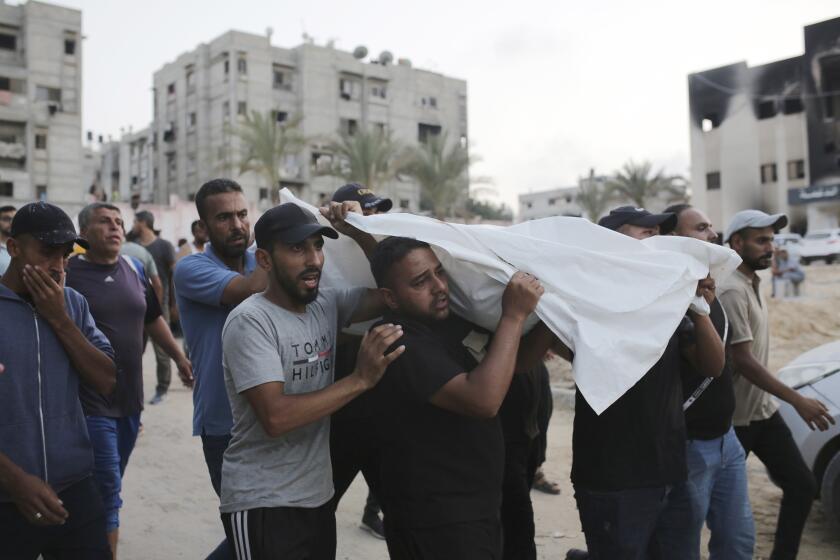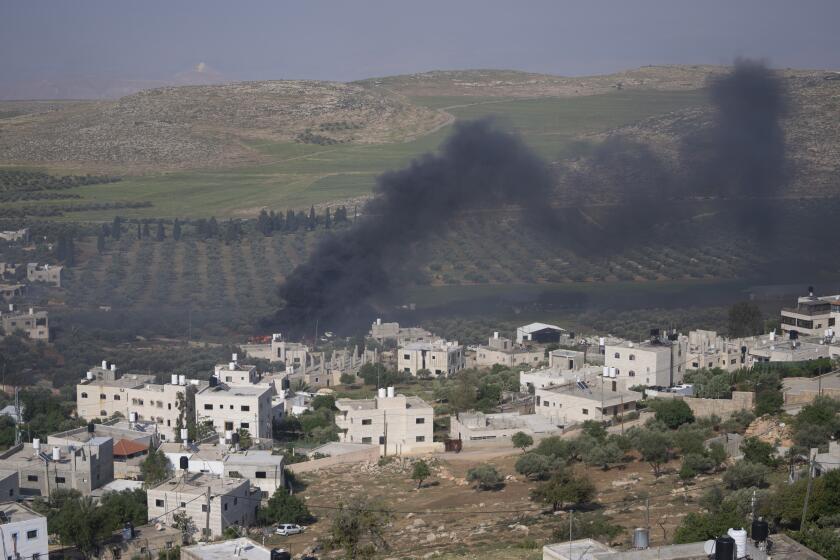Ultra-Orthodox protest against order to enlist in Israeli military turns violent in Jerusalem
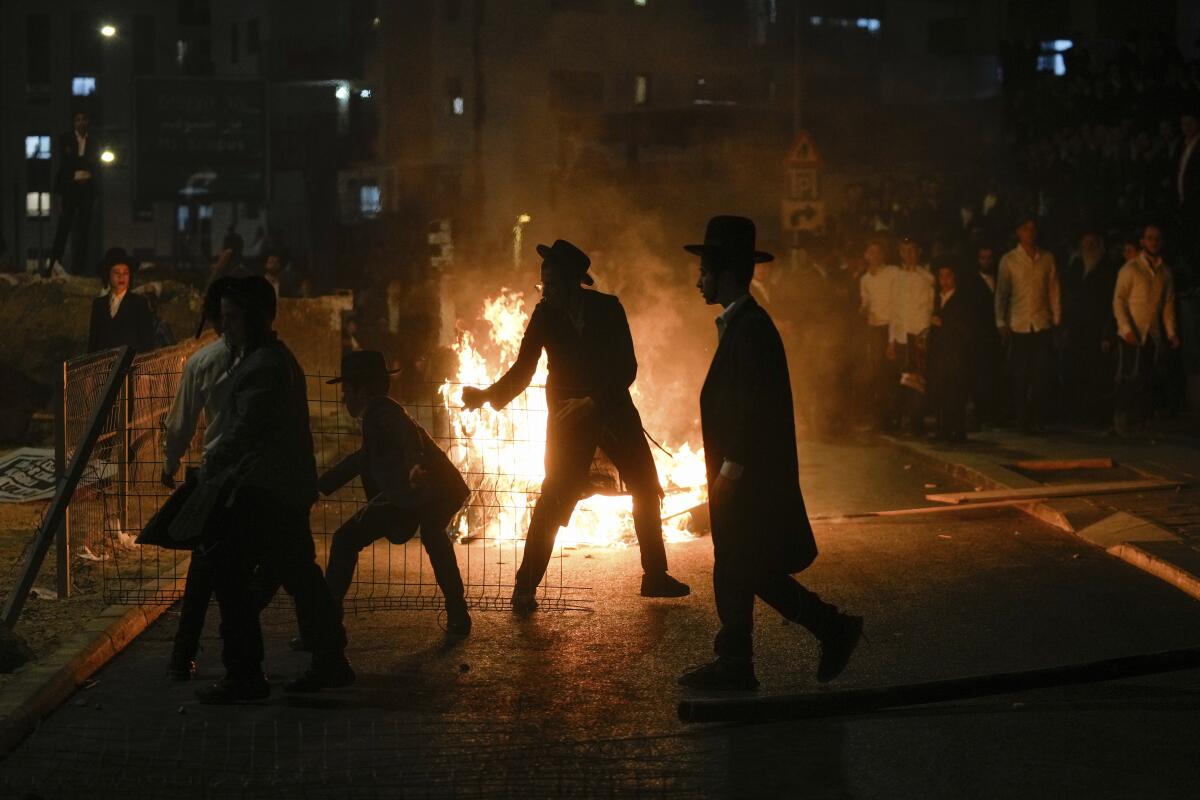
- Share via
JERUSALEM — Thousands of Jewish ultra-Orthodox men clashed with Israeli police in central Jerusalem on Sunday during a protest against a Supreme Court order for them to begin enlisting for military service.
The landmark decision last week ordering the government to begin drafting ultra-Orthodox men could lead to the collapse of Prime Minister Benjamin Netanyahu’s governing coalition as Israel wages war in Gaza.
Tens of thousands of men rallied in an ultra-Orthodox neighborhood to protest the order. But after nightfall, the crowd made its way toward central Jerusalem and turned violent.
Israeli police said protesters threw rocks and attacked the car of an ultra-Orthodox Cabinet minister, pelting it with stones. Water cannons filled with skunk-scented water and police mounted on horses were used to disperse the crowd. But the demonstration was still not under control late Sunday.
U.S. sanctions fundraisers for extremist West Bank settlers who commit violence against Palestinians
The Biden administration is imposing sanctions on entities accused of fundraising for extremist Israeli West Bank settlers who attacked Palestinians.
Military service is compulsory for most Jewish men and women in Israel. But politically powerful ultra-Orthodox parties have won exemptions for their followers to skip military service and instead study in religious seminaries.
The long-standing arrangement has bred resentment among the broader public, a sentiment that has grown stronger during the eight-month war against Hamas. More than 600 soldiers have been killed in fighting, and tens of thousands of reservists have been activated, upending careers, businesses and lives.
Ultra-Orthodox parties and their followers say forcing their men to serve in the army will destroy their generations-old way of life. Earlier Sunday, thousands of men crowded a square and joined in mass prayers. Many held signs criticizing the government, with one saying “not even one male” should be drafted.
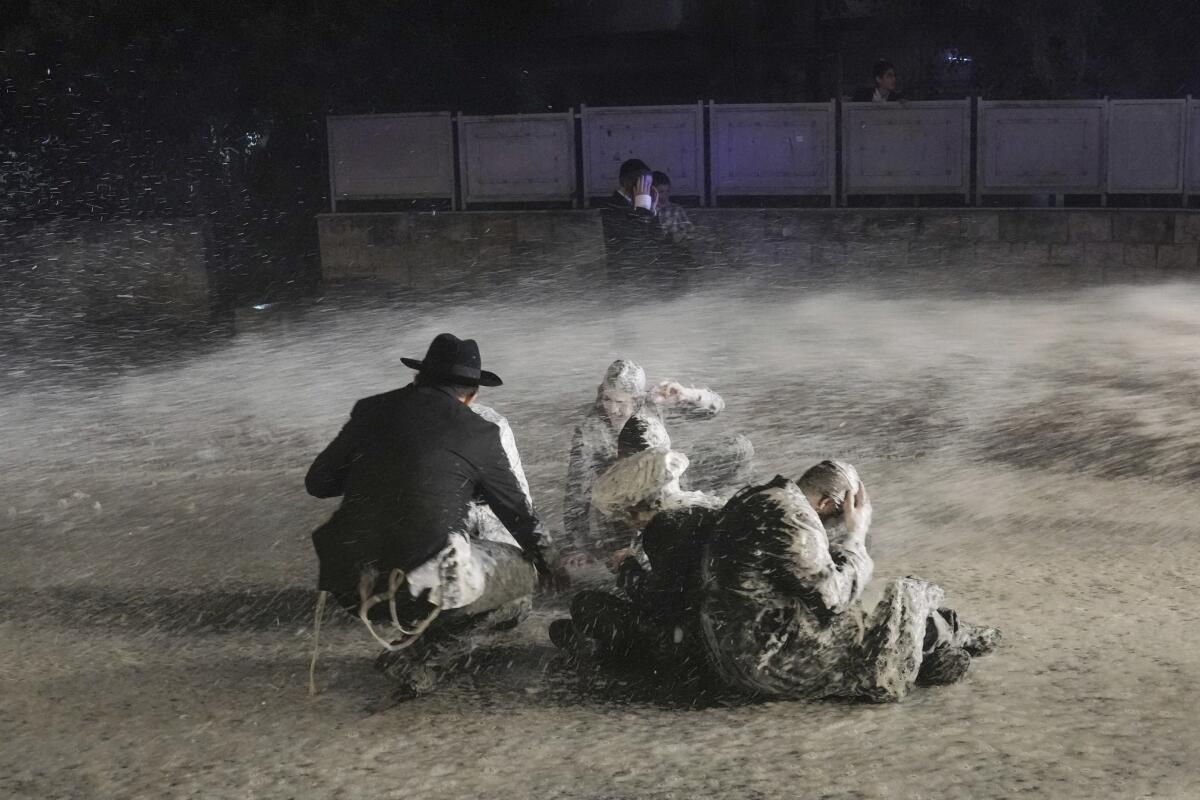
The ultra-Orthodox parties are key members of Netanyahu’s governing coalition and could potentially force new elections if they decide to leave the government in protest.
Party leaders have not said whether they will leave the government. Doing so could be risky, with Netanyahu’s coalition’s popularity lagging since the Oct. 7 Hamas attack that sparked the war.
The Israeli army says an Israeli man was shot dead in a Palestinian town in the northern West Bank while deadly strikes rocked northern Gaza.
Also on Sunday, Israeli troops carried out an airstrike in the northern West Bank, killing a Palestinian militant and wounding five other people, Palestinian health officials said.
The strike took place in Nur Shams, an urban refugee camp that has been a frequent target of the Israeli military and is known as a stronghold of Palestinian militants. The state-run Palestinian news agency Wafa said an Israeli drone fired three missiles and struck a house.
Islamic Jihad identified the dead man as Saeed al-Jaber, one of its local commanders. Wafa said he had escaped a previous drone strike June 20. There were no details on the identities of the wounded. Health officials said two were in critical condition.
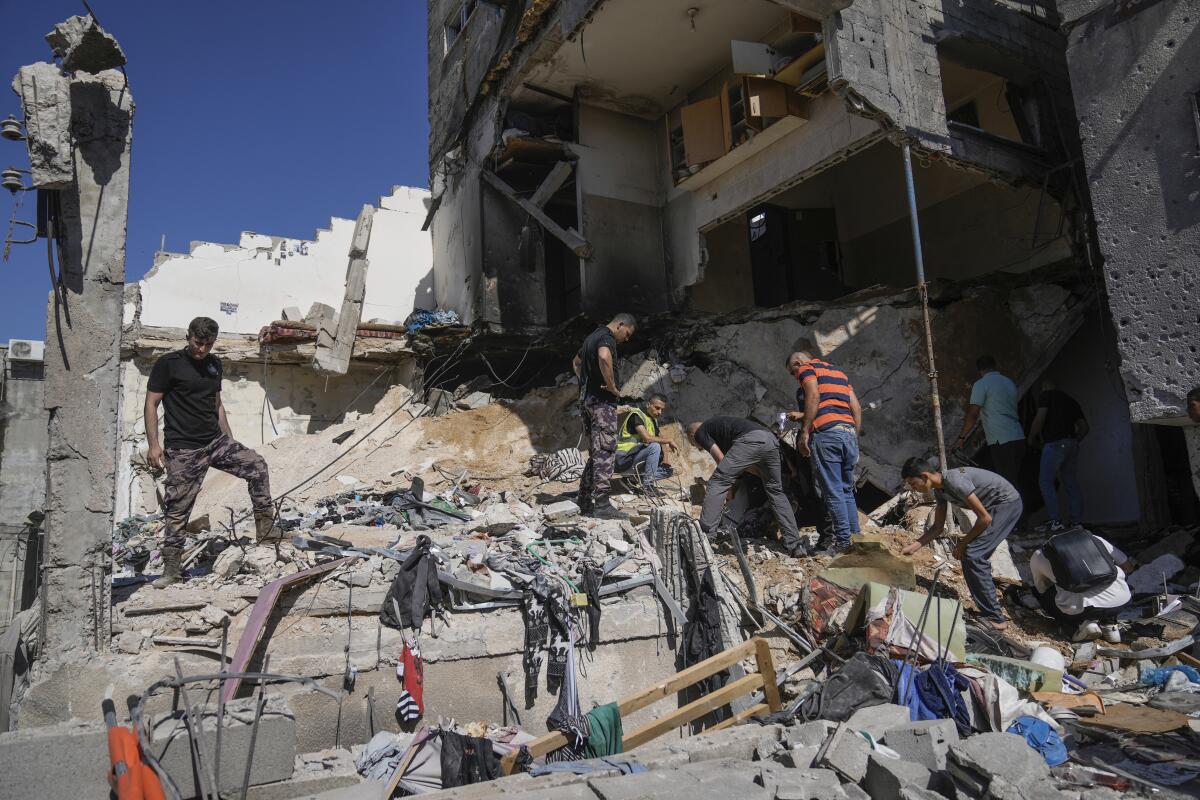
The Israeli military confirmed an attack on the home, saying that militants inside, including Al-Jaber, were responsible for recent attacks on Israeli targets.
The occupied West Bank has experienced a surge in violence since the war in Gaza erupted in October. The Palestinian Health Ministry says more than 500 Palestinians have been killed by Israeli fire in the West Bank since the start of the war. Most have been killed during Israeli raids and violent protests. The dead also include bystanders and Palestinians killed in attacks by Jewish settlers.
The Israeli-occupied West Bank has seen some of its worst violence since the war in nearby Gaza began. Body of missing Israeli teen found.
Israel launched an aerial and ground offensive in Gaza in response to the Hamas attack on southern Israel on Oct. 7 that killed about 1,200 people and took 250 others hostage. More than 37,800 Palestinians have been killed in the offensive, according to Gaza’s Health Ministry, which doesn’t distinguish between civilians and combatants in its toll.
Israeli forces have been battling Palestinian militants in an eastern part of Gaza City, Shijaiyah, in recent days. Israel returned to the neighborhood months after saying it had completed operations in the area.
Hamas has repeatedly regrouped in hard-hit areas after Israeli troops pulled out, raising questions about Israel’s commitment to destroying the militant group’s military capabilities.
The latest operation has sent thousands of residents fleeing. The army said Sunday it has killed dozens of militants in “close-quarters combat” and airstrikes, and confiscated weapons from a hideout it said Hamas had kept in a United Nations-supported school.
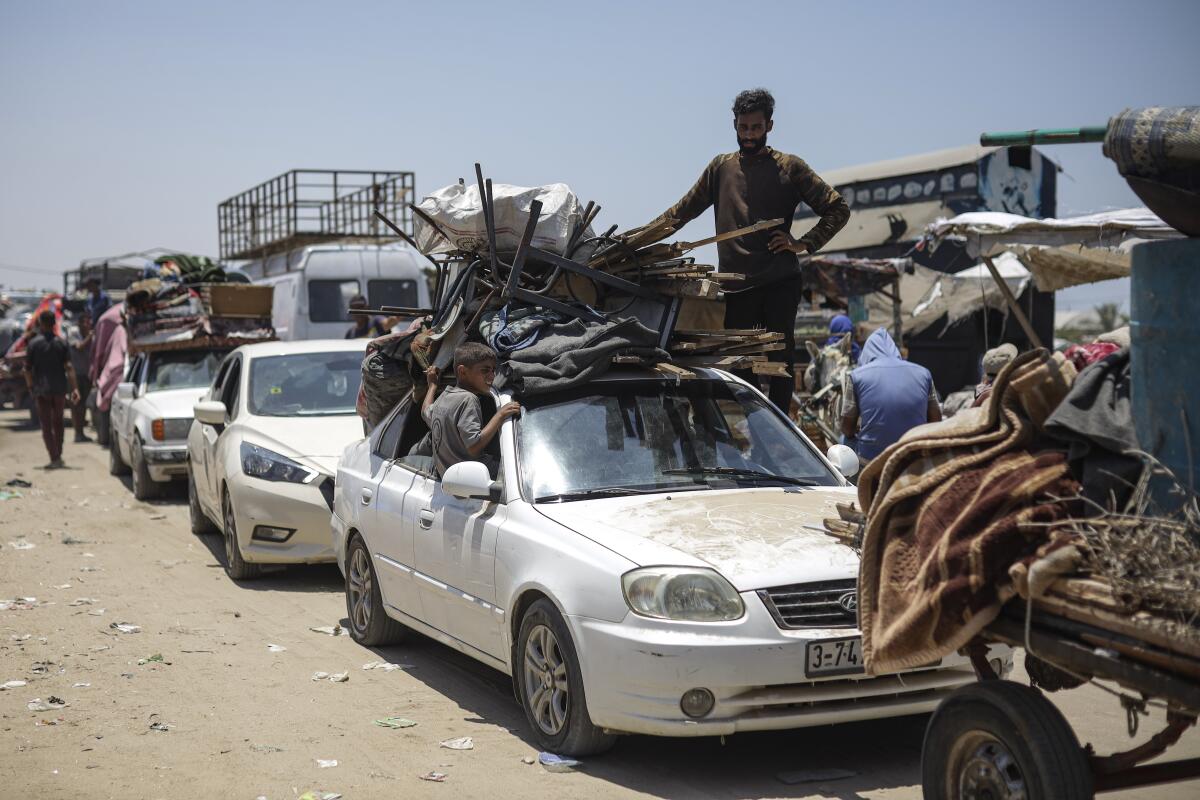
Palestinians also continued to flee the area in and around Rafah, the southern Gaza city where Israel says it is in the final stages of an offensive. More than 1.3 million Palestinians have fled Rafah since Israel’s incursion into the city in early May.
But with few safe places to go, tens of thousands of people have stayed behind, mostly in outlying areas previously thought to be safe. Large groups of people fled with tents, mattresses and clothes piled on trucks or donkey-pulled carts. Many walked on foot as they searched for shelter. Even places thought to be safe suffer from overcrowding and poor health conditions.
For many Palestinians in the war-torn enclave, it was not their first displacement. They say the experience doesn’t get any easier.
“This is the fourth time going from place to place where they [the Israeli military] tells us is a safe area but turns out it isn’t,” Mohammad Hajjaj told the Associated Press. He was first displaced from Shijaiyah in the early weeks of the war.
Hajjaj said that two days ago, he and his family woke to the sound of Israeli tank fire nearby before leaving. “We slept on the streets,” he said.
The fleeing Palestinians found space on a plot of land in nearby Khan Yunis and began setting up their tents alongside dozens of others on the sandy lot.
“We came to Khan Yunis from Muwasi,” said Mervette Shamlakh, referring to the Israeli-designated coastal “humanitarian zone” that has few basic services. “It’s the same thing again and we had to flee … we have no idea where we are supposed to go.”
Zwigenberg writes for the Associated Press. AP writers Majdi Mohammed and Wafaa Shurafa contributed to this report.
More to Read
Sign up for Essential California
The most important California stories and recommendations in your inbox every morning.
You may occasionally receive promotional content from the Los Angeles Times.

